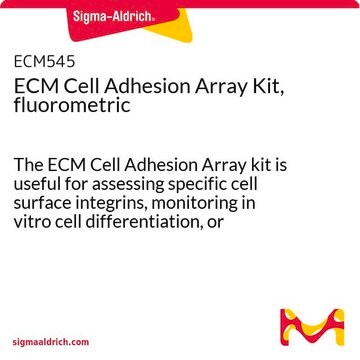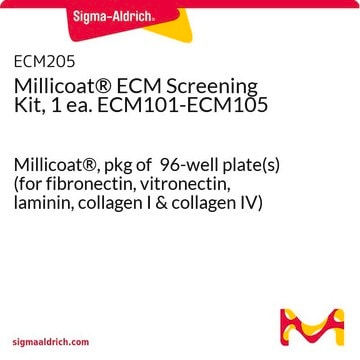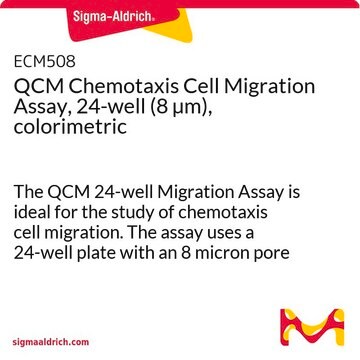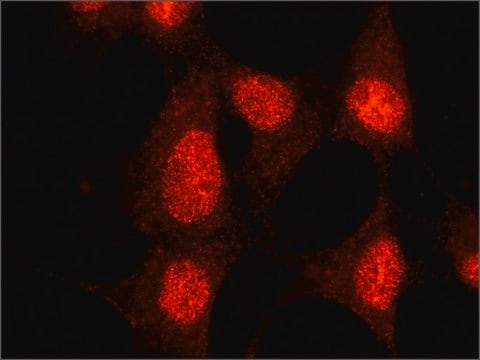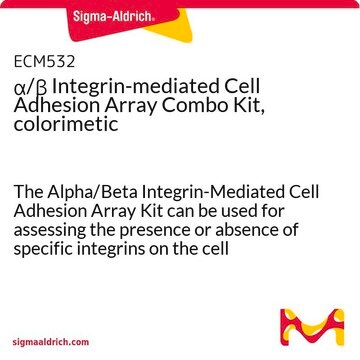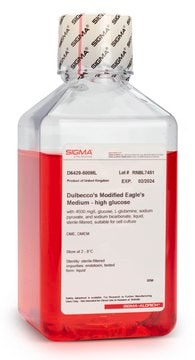This product has not been tested for bacterial cell adherence. However, bacteria are known to bind to immobilized extracellular matrix. The following publication may be of interest for reference: "Adherence of Streptococcus pneumoniae to immobilized fibronectin," Infect Immun. 1995 Nov;63(11):4317–4322. doi: 10.1128/iai.63.11.4317-4322.1995. https://pmc.ncbi.nlm.nih.gov/articles/PMC173614/
ECM540
ECM Cell Adhesion Array Kit, colorimetric
The ECM Cell Adhesion Array kit is useful for assessing specific cell surface integrins, monitoring in vitro cell differentiation, or screening potential cell adhesion promoters/inhibitors.
Sinonimo/i:
Extracellular matrix array cell adhesion assay
About This Item
Prodotti consigliati
Livello qualitativo
Reattività contro le specie
human
Produttore/marchio commerciale
Chemicon®
tecniche
cell based assay: suitable
Metodo di rivelazione
colorimetric
Condizioni di spedizione
wet ice
Descrizione generale
Cell adhesion plays a major role in cellular communication and regulation, and is of fundamental importance in the development and maintenance of tissues. Scientists are continually examining the adhesion, migration, and invasion of many diverse cell types on various extracellular matrix (ECM) component proteins. The CHEMICON ECM Cell Adhesion Array Kit (Colorimetric) provides an ECM Array microtiter plate with a colorimetric detection format, allowing for large-scale screening and quantitative comparison of multiple samples/cell lines. The kit is designed as a rapid (1-2 hours), cost effective, efficient method for characterization of cell adhesion.
In addition, Chemicon continues to provide numerous migration, invasion, and adhesion products including:
· Alpha Integrin-Mediated Cell Adhesion Array Kit (Colorimetric) (ECM530)
· Beta Integrin-Mediated Cell Adhesion Array Kit (Colorimetric) (ECM531)
· Alpha/Beta Integrin-Mediated Cell Adhesion Array Combo Kit (Colorimetric) (ECM532)
· Alpha Integrin-Mediated Cell Adhesion Array Kit (Fluorimetric) (ECM533)
· Beta Integrin-Mediated Cell Adhesion Array Kit (Fluorimetric) (ECM534)
· Alpha/Beta Integrin-Mediated Cell Adhesion Array Combo Kit (Fluorimetric) (ECM535)
· ECM Cell Adhesion Array Kit (Fluorimetric) (ECM545)
· QCM 8μm 96-well Chemotaxis Cell Migration Assay (ECM510)
· QCM 5μm 96-well Chemotaxis Cell Migration Assay (ECM512)
· QCM 3μm 96-well Chemotaxis Cell Migration Assay (ECM515)
· QCM 96-well Cell Invasion Assay (ECM555)
· QCM 96-well Collagen-Based Cell Invasion Assay (ECM 556)
· 24-well Insert Cell Migration and Invasion assay systems
· CytoMatrix Cell Adhesion strips (ECM protein coated)
· QuantiMatrix ECM protein ELISA kits
Test Principle:
The CHEMICON ECM Cell Adhesion Array kit utilizes a colorimetric detection format, allowing large-scale screening and quantitative comparison of multiple samples. Each kit contains a 96-well, microtiter plate consisting of 12 X 8-well removable strips. Each well within a strip (7 wells total) is pre-coated with a different ECM protein (see table below) along with one BSA-coated well (negative control). Experimental cells are seeded onto the coated substrates, where adherent cells are captured. Subsequently, unbound cells are washed away, and the adherent cells are fixed and stained. After stain extraction, the relative cell attachment is determined using absorbance readings.
Additional information about the ECM components provided in the kit:
Applicazioni
Cell Structure
For Research Use Only. Not for use in diagnostic procedures.
Confezionamento
Componenti
Cell Stain Solution: (Part No. 90144) One bottle - 20 mL.
Extraction Buffer: (Part No. 90145) One bottle - 20 mL.
Assay Buffer: (Part No. 90601) One bottle - 100 mL.
Stoccaggio e stabilità
Precautions:
· Cell stain contains minor amounts of crystal violet, a toxic substance, which may cause cancer and heritable genetic damage. Handle with caution. Toxic by inhalation and if swallowed. Irritating to eyes, respiratory system and skin.
· Extraction buffer contains alcohol. Avoid internal consumption.
Note legali
Esclusione di responsabilità
Avvertenze
Danger
Indicazioni di pericolo
Consigli di prudenza
Classi di pericolo
Eye Irrit. 2 - Flam. Liq. 2
Codice della classe di stoccaggio
3 - Flammable liquids
Punto d’infiammabilità (°F)
53.6 °F
Punto d’infiammabilità (°C)
12 °C
Certificati d'analisi (COA)
Cerca il Certificati d'analisi (COA) digitando il numero di lotto/batch corrispondente. I numeri di lotto o di batch sono stampati sull'etichetta dei prodotti dopo la parola ‘Lotto’ o ‘Batch’.
Possiedi già questo prodotto?
I documenti relativi ai prodotti acquistati recentemente sono disponibili nell’Archivio dei documenti.
I clienti hanno visto anche
-
We are trying to investigate bacterial cell adherence. Are bacterial cells able to bind onto the well plate?
1 answer-
Helpful?
-
Active Filters
Il team dei nostri ricercatori vanta grande esperienza in tutte le aree della ricerca quali Life Science, scienza dei materiali, sintesi chimica, cromatografia, discipline analitiche, ecc..
Contatta l'Assistenza Tecnica.